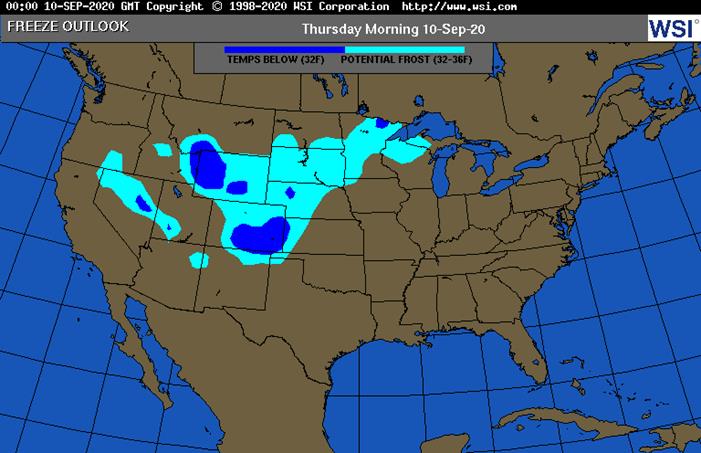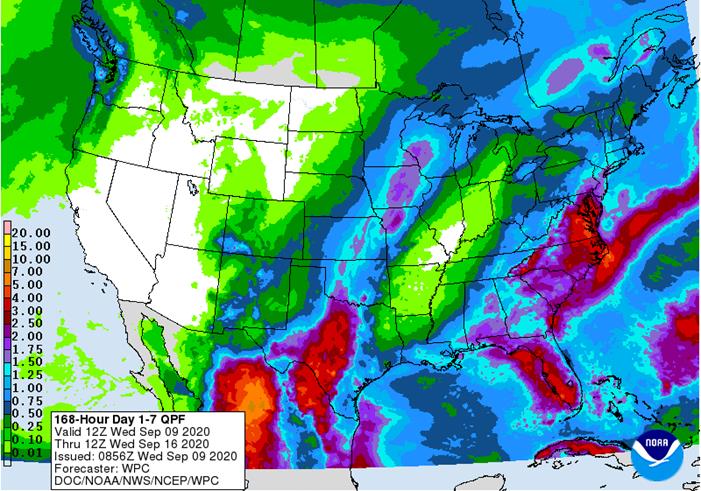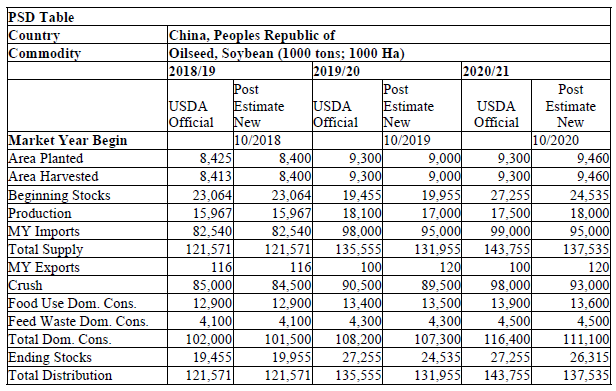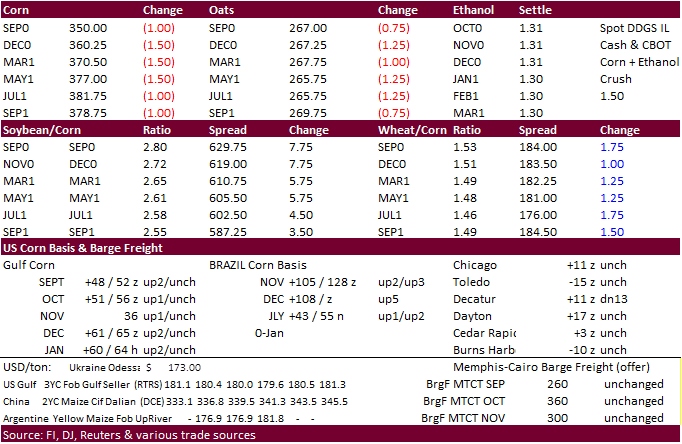PDF Attached


- Additional
frost and freezes occurred this morning from eastern Canada’s Prairies through northern and west-central Minnesota, North Dakota and eastern Montana to eastern Colorado and Wyoming - Early
assessments of the past two days of frost, freezes and general cold suggest the following - Corn,
soybeans, flax and late canola were most seriously harmed by freezes in Saskatchewan and Manitoba Canada Tuesday - Dry
edible beans from Montana and Wyoming to northeastern Colorado and northeast into the northern Red River Basin were also seriously damaged - Sunseed,
sugarbeets were impacted, but sugarbeets will not experience a significant change in production and the cold may increase sugar levels in some of the crop - Cotton
boll lock is feared although not yet confirmed for crops produced from southwestern Kansas into western Texas
- Some
of the crop may come through the cold unscathed and a close watch is warranted - Drought
and dryness along with excessive heat in recent weeks in the northwestern and west-central Plains should have had many summer crops more advanced than usual which should have reduced the impact of recent cold on unirrigated crops - Damage
in the upper Midwest crops has been low so far with a quality decline expected to beans produced in eastern North Dakota and west-central and northern Minnesota - A
few of the most immature soybeans and corn in the Upper U.S. Midwest may have been more seriously impacted, but the impact on national production should be low - Another
cool night is expected tonight in the northern and west-west-central Plains as well as the upper Midwest and southwestern U.S. Plains - New
damage will be limited to parts of Wisconsin and Minnesota, but the impact will be low and similar to that noted above - Ongoing
concern over cotton bolls in the southwestern Plains will continue into Friday morning - Dryness
in central and eastern Ukraine, Russia’s Southern Region and western Kazakhstan remains quite serious and little to no relief is expected for at least ten days and more likely another two weeks - Dryness
also remains a serious concern in portions of southeastern Europe – mostly in the lower Danube River Basin, southeastern Roman and eastern Bulgaria - France
and Germany are in need for rain and very little is expected for at least a week
- Some
forecast models are suggesting some moisture will occur late next week and into the following weekend in parts of France and Germany - Russia’s
eastern New Lands will begin receiving rain again in the second half of next week - The
region will dry down for nearly a week - The
break from frequent rainfall will be good and should help get some fieldwork to advance - There
is some concern that West Siberian small grains and sunseed might have been negatively impacted by recent frequent rain - Northwestern
Russia precipitation is expected to occur periodically in the next couple of weeks resulting in some slowing of winter wheat and rye planting and establishment as well as some delay to 2020 harvesting - However,
favorable weather has occurred up until now supporting fieldwork and early winter crop emergence - Northeastern
China received additional heavy rainfall of 2.00 to more than 6.00 inches Tuesday from remnants of Typhoon Haishen - Flooding
remains a serious issues in northeastern China from too much rain since mid-August - Rain
will prevail in portions of northeastern China through the weekend delaying a much needed drying trend and leaving concern over soybean and corn conditions in eastern Liaoning and Jilin as well as a part of Heilongjiang - Too
much rain since mid-August has delayed crop maturation and induced some concern for crops produced in low-lying areas - Another
frontal system is expected early next week that will generate another wave of rain further delaying crop maturation and harvesting - East-central
China weather should be favorably mixed over the next ten days supporting late season crop development and allowing some crop maturation to take place - Soil
moisture will be good for early season wheat planting later this month and in October
- Xinjiang,
China weather will be mostly good for crop maturation and harvest progress over the next couple of weeks.
- Western
Argentina remains too dry with little change likely, although rain will fall in southern and northeastern Argentina over the coming week - Southern
Argentina will receive a few more light showers during mid- to late week this week, but the impact on soil moisture and crop conditions will be low - Moisture
totals will vary from 0.05 to 0.35 inch except near the Buenos Aires south coast where rainfall may range from 0.50 to 1.50 inches - Northeastern
Argentina will get some rain late this week benefiting a few grain and cotton areas with follow up rain in the same area during mid- to late-week next week - There
is still no relief expected for the drought areas of western Argentina during the coming ten days - Australia
still needs significant rain to support reproduction in Queensland, northern New South Wales and northern parts of Western Australia - Mexico
and Central America have trended much wetter recently and the trend will continue; relief from dryness in Honduras and Nicaragua is becoming more complete - West-central
Africa remains too dry especially in Ghana and eastern coffee and cocoa production areas of Ivory Coast - Tropical
Storm Paulette was over open water in the central Atlantic Ocean and will stay over open water through the next week posing no threat to land - Tropical
Storm Rene was west northwest of the Cabo Verde Islands this morning and it will stay over open water while intensifying over the next several days - The
storm may become a Hurricane later in the week - Rene
poses no threat to land - Tropical
Wave 400 miles southeast of North Carolina will move to the U.S. Carolina Coast Thursday - Some
development is possible into a tropical depression, although confidence is low and the impact on crop areas will be very low as well - Brazil
rainfall will continue greatest in the far south of the nation for at least the next ten days - Rain
is advertised from Parana to southern Minas Gerais Sep 21-23, but the event is too far out in time to have much confidence - The
moisture would reach into some citrus, sugarcane and coffee production areas and might be good for early corn, but early indications suggest only light rain - Center
west Brazil looks to be dry and very warm to hot through Sep. 23 - South
Africa will be mostly dry the remainder of this week except in a few coastal areas - More
rain is needed to support winter crop development and improve soil moisture for spring and summer crop planting next month - Northern
India will be dry this week while rain falls in central, southern and eastern parts of the nation - Cotton
conditions will improve after being too wet earlier this month - Improved
rainfall occurred in Indonesia and Malaysia recently - More
precipitation is needed in Sumatra and western Java where it has been driest in recent months - Some
erratic rainfall is expected over the next ten days with many areas getting additional moisture - Mainland
areas of Southeast Asia continued to report erratic rainfall recently - Crop
conditions are rated favorably, but greater rain is needed to ensure good water supply over the dry season - Water
supply has not been replenished very well this year and greater rain is needed
- Rain
has been greatest in northern Luzon Island recently while most other areas in the Philippines have experienced net drying - Philippines
rainfall should increase during the coming week - Australia
weather over the coming week will include some light rainfall over some of the nation’s winter crop region, but most of the rain will be a little too light to seriously bolster soil moisture
- Showers
will occur today into Friday from Eastern New South Wales into southeastern Queensland - Some
forecast models are increasing rain for New South Wales, Queensland and Victoria after Sep. 16, but confidence is low - Pakistan
weather is improving after flooding in late August - Central
and southern Pakistan was dry during the weekend - Very
little rain will fall over the next ten days - Ontario
and Quebec will experience a good mix of rain and sunshine over the next two weeks; some drying will be needed thereafter to induce better crop maturation and harvest conditions -
New
Zealand rainfall will be erratically distributed for a while and temperatures will be a little cooler biased -
Southern
Oscillation Index was +8.70 today and it will stay positive the remainder of this week, although some weakening will continue over the next few days
- EIA
U.S. weekly ethanol inventories, production, 10:30am - Malaysian
Palm Oil Board’s end-Aug. palm oil stockpiles, production, export data - Malaysia
palm oil export data for Sept. 1-10 - Conab’s
data on production, area and yield of soybeans and corn in Brazil
FRIDAY,
Sept. 11:
- (Overnight)
China agriculture ministry’s (CASDE) monthly report on supply and demand - USDA
weekly crop net-export sales for corn, soybeans, wheat, cotton, pork, beef, 8:30am - USDA’s
monthly World Agricultural Supply and Demand (Wasde) report, noon - ICE
Futures Europe weekly commitments of traders report, 1:30pm (6:30pm London) - CFTC
commitments of traders weekly report on positions for various U.S. futures and options, 3:30pm - FranceAgriMer
weekly update on crop conditions - New
Zealand food prices
Canadian
Housing Starts Aug: 262.4K (exp 217.5K; prev 245.6K)
US
EIA Cuts Forecast For 2021 World Oil Demand Growth By 490K Bpd, Now Sees 6.53M Bpd YoY Increase
–
Cuts Forecast For 2020 World Oil Demand Growth By 210K Bpd, Now Sees 8.32M Bpd YoY Drop









Source:
Bloomberg and FI
Corn.
-
CBOT
corn ended 1.0-1.50 cents on as expected US corn crop rating and wet weather for the Midwest.
-
The
USD traded down 20 points as of 2:00 PM CT. -
Apparently,
President Trump directed the EPA to deny dozens of refiner requests for retroactive waivers from concerns the issue was costing him politically, according to three sources via a Reuters article. E20 RINs were up to 55 early this morning vs. 47 yesterday.
-
China
cash corn prices bias northeastern region increased by nearly 30 percent from the start of the year to 2,355 yuan (HK$2,661) per ton at the beginning of August, before falling slightly to 2,274 yuan per ton at month’s end, according to the National Bureau
of Statistics data via Reuters article. Heavy flooding from three typhoons have supported prices and likely lowered production.
-
Europe
will see restricted rainfall this week and temperatures will be above normal.
-
BB
– AstraZeneca Plc stopped giving shots of its experimental coronavirus vaccine after a person participating in one of the company’s studies got sick, a potential adverse reaction that could delay or derail efforts to speed an immunization against Covid-19. -
USDA
reported US weekly broiler-type eggs set in the United States up 1 percent and chicks placed down 2 percent. Cumulative placements from the week ending January 4, 2020 through September 5, 2020 for the United States were 6.69 billion. Cumulative placements
were down 1 percent from the same period a year earlier.
The
table above reflects China animal unit growth, for July versus previous month and year ago. I don’t think China is done buying corn. For soybeans, imports could top 100 million tons for 2020-21. USDA official is at 99 million tons (98MMT for 2019-20) while
FAS Attaché sees only 95 million tons. High internal China corn prices should shift some demand to soybean meal and feed wheat. Regarding corn stocks, no one knows. That’s why you need to remove China from the rest of the world.
USDA
Attaché – China soybeans

-
None
reported


-
December
is seen in a $3.40-$3.85 range. 2020-21 to average $3.75 for corn and $2.85 for oats.

